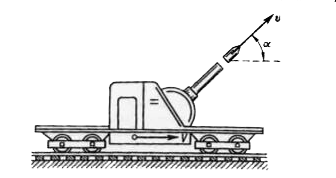A railway flat car, whose mass together with the artillery gun is M, moves at a speed V. The gun barrel makes an angle with the horizontal. A shell of mass m leaves the barrel at a speed v, relative to the barrel. The speed of the flat car in order that it may stop after the firing is
mvcosαM−m
mvM+m
(M+m)vcosα
MvcosαM+m
The correct Answer is:A
Topper's Solved these Questions
- APPENDICES (REVISION EXERCISE)BOOK - AAKASH SERIESCHAPTER - APPENDICES (REVISION EXERCISE)EXERCISE - MOTION IN A PLANE
79 Videos
- APPENDICES ( REVISION EXERCISE )BOOK - AAKASH SERIESCHAPTER - APPENDICES ( REVISION EXERCISE )EXERCISE - REVISION EXERCISE (MOVING CHANGES & MEGNETISM)
95 Videos
- ATOMSBOOK - AAKASH SERIESCHAPTER - ATOMSEXERCISE - PRACTICE EXERCISE
21 Videos
Similar Questions
A railway flat car, whose mass together with the artillery gun is M=2m, moves at a speed V. The gun barrel makes an angle α=60∘ with the horizontal. A shell of mass m leaves the barrel at a speed v=12ms−1, relative to the barrel. Find the speed of the flat car V (in ms−1) in order that it may stop after the firing.
View SolutionA railway flat car, whose mass together with the artillery gun is M=2m, moves at a speed V. The gun barrel makes an angle α=60∘ with the horizontal. A shell of mass m leaves the barrel at a speed v=12ms−1, relative to the barrel. Find the speed of the flat car V (in ms−1) in order that it may stop after the firing.
View Solution
Knowledge Check
A railway flat car has an artillery gun installed on it. The combined system has a mass M and moves with a velocity V. The barrel of the gun makes an angle a with the horizontal. A shell of mass m leaves the barrel at a speed v relative to the barrel. The speed of the flat car so that it may stop after the firing is
AmvM+mB(MvM+m)cosαCmvM+m)cosαD(M+m))cosα
A railway flat car has an artillery gun installed on it. The combined system has a mass M and moves with a velocity V. The barrel of the gun makes an angle a with the horizontal. A shell of mass m leaves the barrel at a speed v relative to the barrel. The speed of the flat car so that it may stop after the firing is
View SolutionA railway flatcar whose mass together with the artillery gun is M moves at a speed V along the x-axis

The gun barrel makes an angle a with this axis. A projectile of mass m leaves the gun at speed v (relative to the gun) in the direction of the flatcar's motion. Find the speed of the flatcar after the gun has been fired. What should the speed of the flatcar be for it to stop after the firing? Neglect friction.
Put M = 10 tons, m = 120 kg, V = 6.0 mis, v = 900 m/s, α=30°.
View SolutionA car has a gun mounted on it. The combined system has a mass 10m and moves with a velocity V. The barrel of the gun makes an angle 37° with the horizontal. A shell of mass m leaves the barrel at a speed 50 m/s relative to barrel in the forward direction. The speed v of the car so that it may stop after the firing is
View SolutionA car has a gun mounted on it.The combined system has a mass 10m and moves with a velocity v.The barrel of the gun makes an angle 37^(@) with the horizontal.A shell of mass m leaves the barrel at a speed 50m/s relative to barrel in the forward direction.The speed v of the car so that it may stop after the firing is
View SolutionA shell leaves the barrel of a gun at a speed of 800 m/s. The barrel is 2.0 m long. Find the average acceleration.
View SolutionA gun of mass M fires a bullet of mass m with a velocity v relative to the gun. The average force required to bring the gun to rest in 0.5 sec. is
View SolutionA gun (of mass M ) whose barrel makes an angle α with the horizontal fires a shell (of mass m ) . The gun is mounted on a frictionless track , so that recoil takes place with no resistive forces . Find the recoil velocity V of the gun and the absolute velocity of the shell in magnitude and direction if the muzzle velocity of the shell relative to the barrel is v .
View Solution
